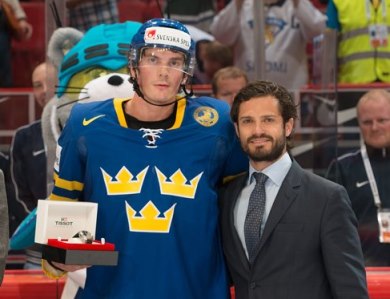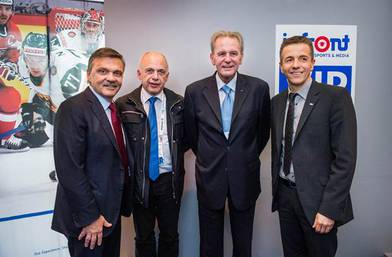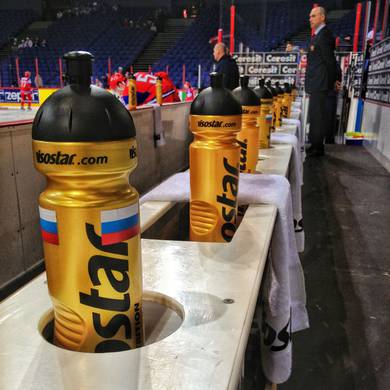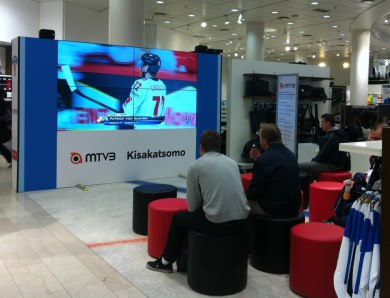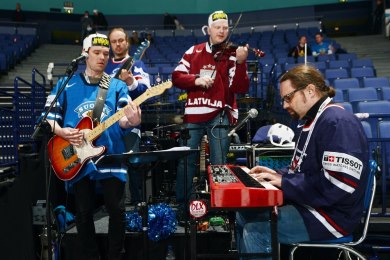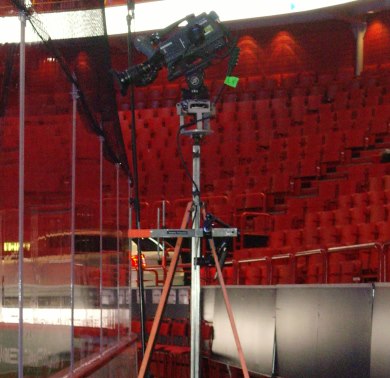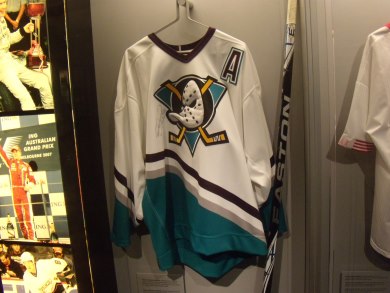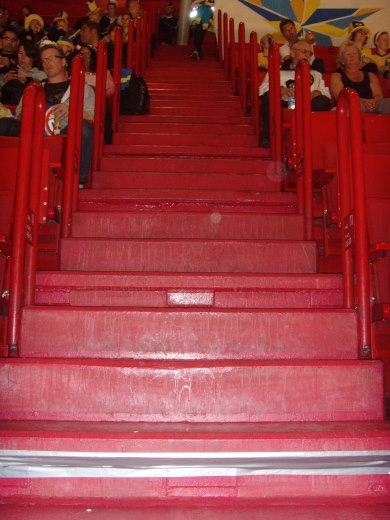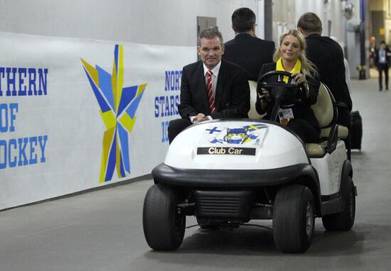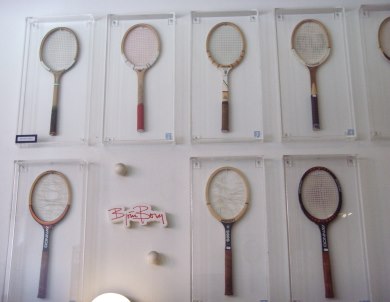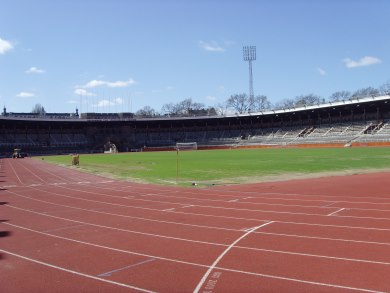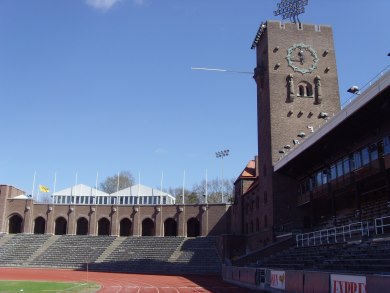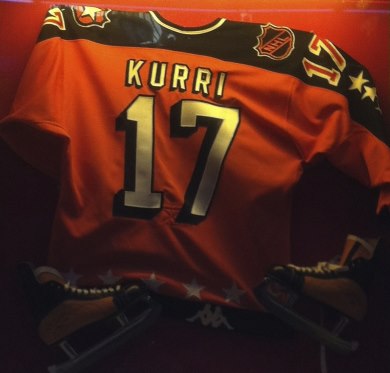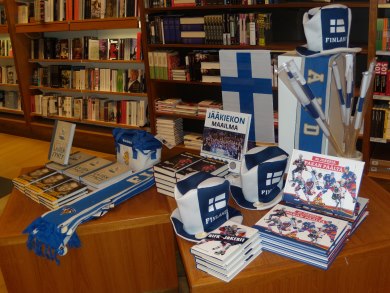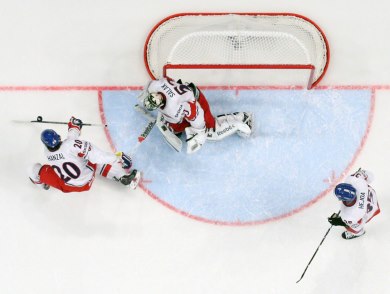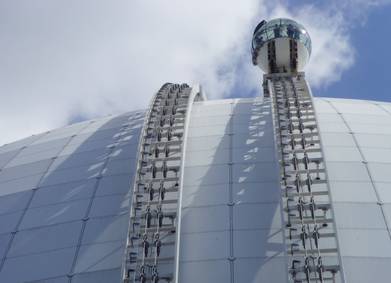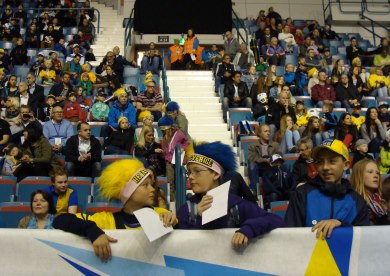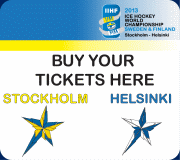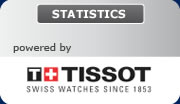Welcome to the 2013 IIHF Ice Hockey World Championship blog. Throughout the championship you will be able to read about our impressions behind the ice in Stockholm and Helsinki.
Martin Merk / 18 May / Stockholm
During the three weeks of World Championship action also several celebrities showed up to watch games at the arenas.
Russian President Vladimir Putin paid Helsinki a visit already in the preliminary round and Sweden’s Prince Carl Philip was happy to present Swedish forward Loui Eriksson the prize for the best player, a Tissot watch, after his two-goal performance in the semi-final win against Finland.
The late semi-final game was attended by Swiss President Ueli Maurer and also Jacques Rogge, President of the International Olympic Committee, watched the semi-final games in Stockholm.
More celebrities are expected on Sunday when the IIHF Hall of Fame Induction Ceremony will take place to honour several hockey legends prior to the medal games. The Canadian, Finnish and Swedish induction jerseys are currently auctioned and the proceedings fully go to the charity of the former players’ choice.
Martin Merk / 16 May / Stockholm
Fans in Stockholm, Helsinki and on TV might have noticed the black Isostar bottles used on the player benches and by the goalies to stay hydrated during the game. For the last 24 years the company has provided the sports drink to the hockey stars on the world stage.
All teams use these bottles. All? In the case of Russia the story is slightly different. The golden colour of the bottles remind that this is the defending champion and that the gold fever is – despite some hiccoughs in the preliminary round – not over yet.
“Originally we only had black bottles but for the last three years we’ve been offering golden bottles. That was when we had the idea to produce them for the defending champion,” said Rainer Wegner, Isostar Event Manager.
The first team to showcase the golden Isostar bottles were the Czechs in the 2011 Worlds in Slovakia.
One year later, though, it was back to all-black.
“We offered it to the Finns, but they didn’t want it. They were kind of superstitious and preferred the normal bottles,” Wegner said. “But when we offered it to the Russian team, they were more than happy to play with golden bottles, and they were so proud that they stuck their flag on it.”
Will it provide subliminal help to defend the world title? The last team that won back-to-back World Championships were the Russians in 2008 and 2009.
Risto Pakarinen / 15 May / Helsinki
I don’t like shopping. Shopping for clothes, that is. I’m one of those people who buy two pairs of jeans when they find one that they like, and if I’m feeling completely crazy, I may buy two pairs that are different colour. But I do love my wife so I happily join her when she goes shopping, and I like to think that I have evolved over the years, too.
In fact, I know I have, because years ago, I used to just stand outside the fitting rooms and text with my friends, and these days I don’t text anymore because I’m on Facebook.
However, I think Stockmann, the famous department store in downtown Helsinki, may be on to something now. In their men’s department, next to shirts and ties, and Team Finland merchandise, there are some chairs, and a big screen on which shoppers can watch the World Championship games.
Stockmann - which happens to be Europe’s sixth biggest department store, and the biggest in the Nordics - shies away from calling it what it really is: a spouse park. It’s meant for people like me who happily join their spouses to the store, but don’t want to miss a second of Worlds action.
They may not want to call it that, but I applaud them for doing it. It’s a true win-win situation. At home. Not on the ice. There are no win-wins in the tournament anymore.
Lucas Aykroyd / 13 May / Helsinki
If you enjoy live renditions of Van Halen, AC/DC, Santana, and other classic rock music, Hartwall Arena has been the place to be since the tournament kicked off on May 3. Game after game, both during stoppages in play and intermission, the talented local cover band Jimmy Cola has been cranking out the hits from one rinkside corner of the arena.
How did this six-piece outfit land such a coveted gig?
“We were first invited by the Finnish Ice Hockey Association to play at the Channel One Cup game here on December 13 between the Czechs and the Finns [a 3-2 Finnish win],” singer Jussi Mikkola told IIHF.com backstage. “They had this idea that there should be some live music at the World Championship. We were wondering how this would work technically. That was a big question mark. But everything went well at that break game in December.”
And here they are now, happily sporting jerseys that represent the different national teams. Of course, their challenge is to not get so caught up in performing that they interfere with the action when play resumes.
“We’re all big ice hockey fans,” said Mikkola. “Our drummer Epe Liukkonen even played in the Finnish youth national teams. So Eppe is always nailing the beat. When the puck goes out of play, he tries to make sure that everybody stops on the next beat. Through the tournament, we’ve gotten quite good at it.”
Jimmy Cola has a potential set list of 200 to 300 songs, but it’s all about picking the right ones for the atmosphere at the games. Having violin player Juha Sokka comes in handy for the arrangements when they want to do Russian tunes like “Kalinka”, for instance.
“We try to represent all the countries, something reflecting their own culture,” said Mikkola. “That was the easy part. And with bands like AC/DC and Van Halen, people always get into the spirit of ice hockey from them.”
Playing day in and day out poses a physical challenge for musicians, even veterans like the Jimmy Cola guys. They typically play between 100 and 150 shows all over Finland each year, from clubs to corporate events.
While they’re loving the opportunity to mostly stay put in Helsinki during the Worlds, the workload doesn’t slow down for them. And Mikkola has to be aware of preserving his voice, as he mimics everyone from Jon Bon Jovi to Michael Jackson.
“The other day, we had a gig in Lappeenranta,” said Mikkola. “We drove there [close to three hours one way] and then we came back today. Today we’re a little bit tired. But I have done singing for a long time. The arena isn’t an easy environment to sing in, because it changes all the time between coldness and warmth. I’m hanging in there.”
Andrew Podnieks / 13 May / Stockholm
Take a look at this photo behind one net at the Globe Arena. Notice two things. One, there is no red light atop the glass. Two, there is no goal judge holding a clicker to illuminate the red light. “We don’t use the red light or goal judge here,” said Mikael Krantz of Mediatec, which runs the game from a video and broadcast perspective. Indeed, when a goal is scored these days, the referee points to the net and blows his whistle, the scoring team celebrates, and the players go back to centre ice for the faceoff. If there is a dispute about the goal, the referees “go upstairs” for video review, but the decades-old tradition of having an official behind the net to announce a goal is, officially, dead. Cameras have made him redundant.
Lucas Aykroyd / 12 May / Helsinki
Want to relive some glorious hockey history while you look forward to the excitement of the quarter-finals? If so, head to Helsinki’s Olympic Stadium, just a short tram ride away from Hartwall Arena.
The stadium – built in 1938 with 3,500 cubic metres of wood, 4,000 tons of cement, and 1,000 tons of iron to host the 1952 Summer Olympics – is home to the Sports Museum of Finland (€5 adults, free for children under 18). It includes a nice selection of hockey artifacts amid all the tributes to cross-country skiers and distance runners.
You can check out Jari Kurri’s jersey, gloves, helmet, skates, and stick from his 1990 Stanley Cup run with the Edmonton Oilers. Or admire a 1997 Teemu Selänne jersey from the Anaheim Ducks (who were Mighty in those days), along with a stick the “Finnish Flash” used at the 2010 Olympics.
A small theatre called Kino Nurmi (after the great Turku runner Paavo Nurmi) shows clips of highlights and lowlights in Finnish sports history. Finnish fans will enjoy reliving their nation’s first-ever World Championship victory in Stockholm in 1995 (which, of course, they’re hoping to reprise this year).
Timo Jutila’s celebration on the 4-1 goal that salted away the Lions’ victory rivals what Edmonton’s Nail Yakupov did after scoring to beat Los Angeles in overtime earlier this NHL season. It’s fun to see very young-looking stars like Saku Koivu and Jere Lehtinen in bulbous blue helmets.
Don’t miss the jukebox tucked away in a corner, where you can listen to sports-themed tunes like Finnish pop star Eppu Normaali’s “Urheiluhullu” or “Den Glider In”, the song of the ‘95 Worlds.
After touring the Sports Museum, take the elevator to the 72-meter summit of the stadium tower (€5 adults, €3 children).
You’ll enjoy an epic view that includes the track for the ‘52 Olympics, swimming pools and soccer fields, the cathedrals at the Helsinki harbour, and the roller coasters at Linnanmäki, Helsinki’s famous amusement park.
Andrew Podnieks / 11 May / Stockholm
The Globe Arena is, quite literally, not for the faint of heart. The trip from the mixed zone at street level to the media tribune where we watch the games is exactly 119 stairs long, making it nearly four times more onerous than Hitchcock’s 39 Steps but not as demanding as the Potemkin Stairs in Odessa, Ukraine which are 200 in number.
The 119 also pale besides the world’s longest staircase, which is at Niesen Mountain at Lake Thun, Switzerland, which consists of 11,674 steps.
Elevators at the Globen Steps are not an option in our case (Niesen has a cable car, at least). Taking into account two or three games a day, the number of trips down and, more importantly, up make every day more than a good little workout. Like it or not. The stairs are also winding for much of the trek, making the trip a little dizzying if you try to do it quickly.
Szymon Szemberg / 9 May / Stockholm
It’s a brilliant solution to a rather difficult logistical challenge at the 2013 IIHF Ice Hockey World Championship in Stockholm. The coaches are driven to the post-game press conference by Swedish 2008 Olympic swimmer Hanna Westrin. As you can see by the look in Swiss coach Sean Simpson’s eyes, he is quite jolly both with the unusual means of transportation and the driver.
Background? The host organizers of the Stockholm leg of the Worlds simply couldn’t find space for a press-conference room at the Globen Arena, the main rink. So the entire press centre and the media interview room had to be put at the Hovet, the practice arena.
The small problem is that Hovet is some 200 metres from the Globen and you don’t ask a coach (especially after a loss...) to walk this distance to the press conference. So what do you do? Of course! You get two golf carts which take you between the arenas in less than one minute.
Sometimes the coaches get their own cart, but sometimes they share. And if they do, like in this picture, the losing coach (here Czech Alois Hadamczik) has to take the back seat, and Sean Simpson smiles all the way to the press-conference room.
When the second cart is needed, it is driven by press-conference co-ordinator Pål Burman. Now, take a guess with whom the coaches rather go, with Hanna or Pål? Sometimes Hanna also moderates the press conferences. After retiring from swimming in 2010, she studies Marketing & Communications.
Andrew Podnieks / 9 May / Stockholm
You have to write “B. Borg” like this because this is how the name appeared on the scoreboard at Centre Court of Wimbledon for so many years. The two names – Borg and Wimbledon – are synonymous with tennis greatness. Borg was a promising junior hockey player who gave up the ice for the grass and became an immortal figure on the courts.
Today, he plays at the local “Stockholms tennishall” with the club’s manager and pro, Christer Lundberg. The club has seven courts and was built in 1976 by Jan-Erik Lundqvist, who was one of the top-ranked players in the world pre-Borg. Lundberg took over the operations of the tennis courts eight years ago and has been playing with Borg for years.
I watched the two play this morning, and Borg, his mane white not blond now, has the same grace and skill that I remember during his halcyon days. He serves effortlessly, moves into his service return with the old perfect timing, and keeps both hands on the racquet when hitting his backhand, which used to be a hybrid two-hander wherein he’d let go of the top hand on impact. He moves Lundberg around nicely, but Lundberg can get him with drop shots. Borg huffs and puffs a bit now, his incredible conditioning not as it was when he was a 25-year-old number one, of course, but watching him on a local court is a memory never to be forgotten.
The walls of the tennishall are dotted with Borg’s old racquets, many Wimbledon photos, and more souvenirs from Lundqvist’s career. This little local club is a shrine to greatness on the court, and that greatness still plays. Time stands still, the memories come flooding back. B. Borg was the greatest of them all, the Bobby Orr of tennis, as it were.
Andrew Podnieks / 8 May / Stockholm
If the Vasa Museum is the first place a tourist must visit, the Olympic Stadium is definitely the second. Located in downtown Stockholm, it is in immaculate condition, having celebrated its centenary last year. Built in 1912, it was the main venue for track and field, football, and tug of war (!) when Stockholm hosted the 1912 Summer Olympics. Sweden won the most medals that year, 65, and thereafter it was used by local football teams in the Swedish league. It has also hosted many concerts, including one by the Rolling Stones in 1995 which accounted for a stadium attendance record of 35,200. More improbably, it was also the main venue for the IIHF’s 1949 and 1954 World Championships, the field being frozen and turned into a mid-winter rink for top-level tournaments. Today, the stadium is used as a training facility by a nearby university, and the gates are often open. Tourists can literally walk in and see the stadium from midfield. Small, to be sure, it is easy to imagine the parade of athletes walking along the track 101 years ago, such is the beauty of the building and its well-kept grounds.
Risto Pakarinen / 8 May / Helsinki
As has already been established by my colleague Lucas here, Esa Tikkanen is very much a part of the Helsinki look during the World Championship. How about Finland’s other five-time Stanley Cup champion, Jari Kurri, you ask?
Let me tell you.
Finland’s greatest player seems to pop up a little bit everywhere, just like he did as the conscientious two-way player he used to be.
For instance, he’s on the cover of the tournament program – which, as a side note, at two euro, or 20 krona, is a bargain – together with Mats Sundin. He’s also inside the program, giving his best tips on what to see in Helsinki, his hometown.
Sometimes, he’s on the scoreboard, in thee IIHF’s Green Puck anti-doping campaign.
If you want to see the legend in flesh, just have a look behind the Finnish national team’s bench: The GM is also one of the coaches.
Walking around the Hartwall Arena in Helsinki, you’ll see several Kurri sweaters on the walls. There’s one from an NHL All-Star Game, one from his time with the Edmonton Oilers, one from the short Rangers era, and another 17 from the Finnish national team.
Normally there’s also a banner in the rafters with the number 17 on it. Well, there are two banners, because both Jokerit, his Finnish club team, and the Finnish federation have retired his number.
That’s why it may be a bit of a surprise to see a photo of another Kurri sweater in the Jokerit trophy case on the arena first floor. Among all the Jokerit Helsinki trophies, there’s a photo of Aimo Mäkinen, the founder of Jokerit handing over a red Jokerit Kurri sweater to Jari’s father, Ville. The number on the sweater that Kurri wore with Jokerit before joining the Oilers is – 11.
Andrew Podnieks / 7 May / Stockholm
At the top of any must-do list for visitors to Stockholm is a trip to the Vasamuseet (Vasa Museum). Herein is contained one principal exhibit, a ship called the Vasa which set sail on her maiden voyage on August 10, 1628, and sank after travelling just 1,300 metres (take that, Titanic).
The ship lay at the bottom of Stockholm harbor until 1961, yet after 333 years it was recovered in remarkable condition because the harbous water contains little salt. In fact, when it was lifted to ground, city officials were able to restore 98 per cent of the ship to its original glory.
The exterior was adorned with hundreds of carvings, still immaculate, and much of the boat’s interior was also salvaged, including clothing and jewellery, coins, even medical equipment and a board game, all of which are also on display.
The Vasamuseet itself was constructed in 1990 to house the ship and is the most popular tourist destination in the city. The ship was built by King Gustaf II Adolf of the Vasa family and was 52 metres tall. It was the largest warship ever.
It sank because of poor design – it was too tall and too heavy for its hull – and sank after four of ten sails were hoisted. It quickly lurched to one side, water gushed in, and it sank.
Lucas Aykroyd / 7 May / Helsinki
During a short tournament like the IIHF Ice Hockey World Championship, it’s important to keep your focus on hockey. And while the players are thinking about the next game, going to practice, watching video, getting massages, and trying to get sufficient rest and nutrition, fans can read about our favourite sport.
At least that’s the kind of logic that must have motivated the creation of a special World Championship-themed book display at the Akateeminen Kirjakauppa. It’s located on the second floor of Finland’s largest bookstore, just off the famous Helsinki shopping street of Mannerheimintie.
There’s a 2013 Finnish-language edition of World of Hockey: Celebrating a Century of the IIHF, the official in-depth history which features chapters by IIHF.com staff as well as noted international hockey writers such as Pavel Barta and Igor Kuperman. You can also pick up a Finnish translation of 2002 Olympic gold medalist Theoren Fleury’s no-holds-barred autobiography, Playing with Fire.
Fans of the SM-Liiga will appreciate Mika Wickström’s HIFK-Jokerit, chronicling the rivalry between these two classic Helsinki clubs. In addition, there’s a new biography of Jorma “Jerry Salmi”, a pioneering early Finnish pro who suited up at three Worlds and one Olympics, by Arto Teronen and Jouko Vuolle.
Such essential fashion accessories as blue-and-white Finnish flags, scarves, and top hats are also for sale. This way, you can be properly attired as you hold your book in one hand to read in between whistles, grip your beer with the other, and yell “Suomi!” at the top of your lungs as often as possible.
Andrew Podnieks / 6 May / Stockholm
IIHF photo editor Steve Poirier discovered this gem of a shot from the Czech Republic-Sweden game on May 4 in Stockholm.
Taken using an overhead camera by IIHF photographer Andre Ringuette, it shows Martin Hanzal handling the puck with his own stick in his left hand while handing the lost goalie stick back to Alexander Salak with the other.
Jan Hejda looks on with (we assume) admiration for Hanzal's deft and dexterous display.
Andrew Podnieks / 6 May / Stockholm
The Globe Arena is outfitted with the world’s only funicular of its kind. Rail tracks take two cars up along the side of the arena to the top, some 130 metres above street level, where people have an unobstructed view of the city. Called Skyview, the cars hold 16 people each and are a popular attraction since opening in February 2010.
Martin Merk / 6 May / Stockholm
Can Sweden break the home-ice curse? It didn’t look so promising after losing the opening game to Switzerland, but hope is back after Saturday’s win against the Czech Republic.
Tickets for Tre Kronor games have been a hot commodity in Stockholm as their first two games were sold out although some tickets are still available for Tre Kronor’s Monday game against Belarus.
On Sunday, a day without a game for the Swedish team, fans were given the opportunity to watch the team practise for free in the afternoon.
The doors and some sections of the Hovet rink, which is used for practices during the 2013 IIHF Ice Hockey World Championship, opened for Swedish fans who wanted to make use of the opportunity to overlook the team’s preparation for the next game and come close to the team.
The Sweden-Belarus game is on Monday at 20:15.
Lucas Aykroyd / 5 May / Helsinki
Esa Tikkanen used to drive Wayne Gretzky to distraction when the two former Edmonton Oilers linemates played against each other. Tikkanen, the famously chatty Finnish winger who won five Stanley Cups and bronze at the Olympics (1998) and Worlds (2000), was always assigned to shadow “The Great One”.
So you have to wonder what Gretzky would think about Tikkanen’s latest venture.
Sharp-eyed fans attending the IIHF Ice Hockey World Championship in Helsinki may notice some interesting ads at downtown tram stops. Tikkanen has become the face of a new campaign for Grillimaisteri sausages.
Now, Gretzky said in his 1990 autobiography that he hoped his final NHL goal would go in off Tikkanen’s rear end. However, he also confided to People Magazine in 1982 that he played best on “four hot dogs with mustard and relish”. Hmm.
Maybe Wayne will try one of Esa’s sausages, like it, and decide that he actually wants to be known as “The Grillimaisteri One”.
|


